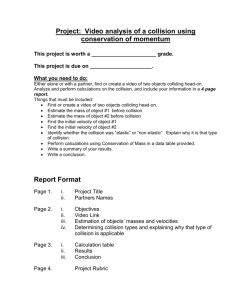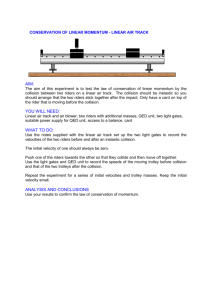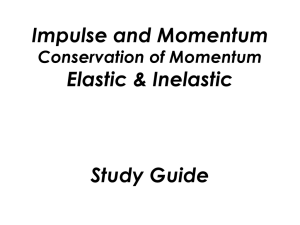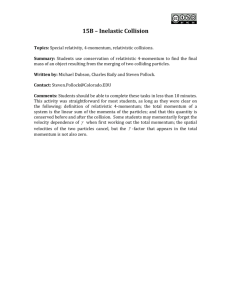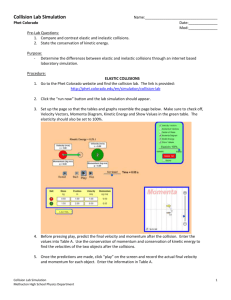Collisions PHeT Activity
advertisement
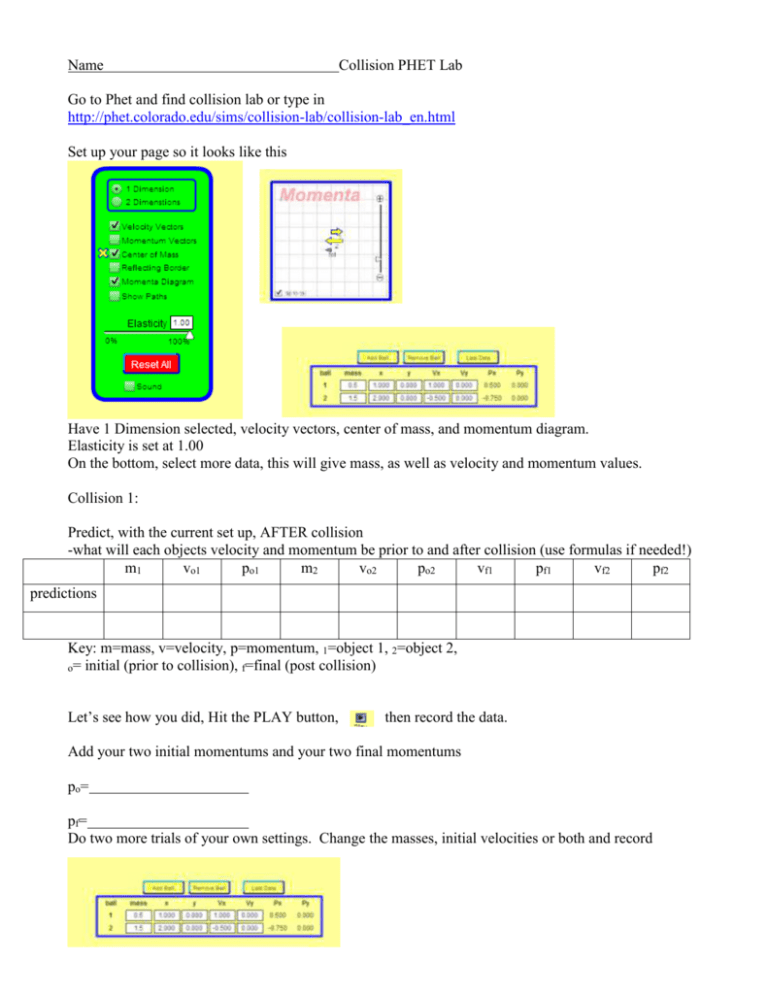
Name Collision PHET Lab Go to Phet and find collision lab or type in http://phet.colorado.edu/sims/collision-lab/collision-lab_en.html Set up your page so it looks like this Have 1 Dimension selected, velocity vectors, center of mass, and momentum diagram. Elasticity is set at 1.00 On the bottom, select more data, this will give mass, as well as velocity and momentum values. Collision 1: Predict, with the current set up, AFTER collision -what will each objects velocity and momentum be prior to and after collision (use formulas if needed!) m1 vo1 po1 m2 vo2 po2 vf1 pf1 vf2 pf2 predictions Key: m=mass, v=velocity, p=momentum, 1=object 1, 2=object 2, o= initial (prior to collision), f=final (post collision) Let’s see how you did, Hit the PLAY button, then record the data. Add your two initial momentums and your two final momentums po= pf= Do two more trials of your own settings. Change the masses, initial velocities or both and record Experiment 2 m1 vo1 po1 m2 vo2 po2 vf1 pf1 vf2 pf2 vo1 po1 m2 vo2 po2 vf1 pf1 vf2 pf2 predictions Experiment 3 m1 predictions For all three experiments find your kinetic energy of each object before and after the collision. Show mathematically if your kinetic energy is conserved bellow with your work. INELASTIC Shift the elasticity bar (or type in new values). ANY NUMBER BUT 1.00 or 0.00 works! When you run, I want you two record the following for pre and post collision. You have full choice as to your masses and initial velocities. Also, watch the TOTAL momentum arrow (the red one in Momenta box)! Record information on next page Experiment 1 Mass of object 1 initial v of 1 = initial p of 1 = Mass of object 2 initial v of 2 = initial p of 2 = Elasticity = Total initial p= START COLLISION Mass of object 1 final v of 1 = final p of 1 = Mass of object 2 final v of 2 = final p of 2 = Did total momentum arrow change? Yes/no Total final p= Experiment 2 Pick a new non-zero, non-1.00 elasticity and run again Mass of object 1 initial v of 1 = initial p of 1 = Mass of object 2 initial v of 2 = initial p of 2 = Elasticity = Total initial p= START COLLISION Mass of object 1 final v of 1 = final p of 1 = Mass of object 2 final v of 2 = final p of 2 = Did total momentum arrow change? Yes/no Total final p= Experiment 3 Now set Elasticity to exactly 0.00 Mass of object 1 initial v of 1 = initial p of 1 = Mass of object 2 initial v of 2 = initial p of 2 = Elasticity = Total initial p= START COLLISION Mass of object 1 final v of 1 = final p of 1 = Mass of object 2 final v of 2 = final p of 2 = Did total momentum arrow change? Yes/no Total final p= Calculate you kinetic energy’s before and after collisions now when you are not fully elastic. 1. Is Kinetic Energy conserved now? If so when 2. Did your total momentum ever change? If so when? 3. When fully inelastic what did the two objects do differently? Click on 2-Dimensions and set the two spheres up so that they strike on an angle. Observe total momentum. Experiment around and see if you previous conclusions hold here. Vary elasticity, mass, velocity and have fun with it! 4. A 2.0 kg mass traveling at 3.0 m/s strikes another 2.0 kg mass traveling at -1.0 m/s. They collide and have a complete elastic collision. If the second mass moves at 3/0 m/s after the collision, what does the first mass do? 5. Let’s say you have a 1.0 kg mass at rest, struck by a 2.0 kg mass traveling at -2.0 m/s. They collide and stick together, thus combining their masses to 3.0 kg. What is the velocity of the combined mass and what type of collision is this? 6. In this situation both objects start combined together. Object one has a mass of 10.0 kg and object two has a mass of 5.0 kg. Combined they are at rest, however they then interact and object one pushes away at 4.0 m/s. What will object two’s velocity be at this point?



